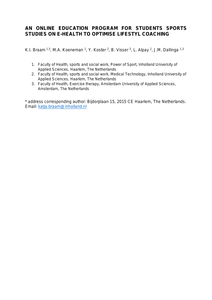In dit abstract wordt de ontwikkeling van een online onderwijsmodule beschreven gericht op eHealth voor leefstijlverbetering
MULTIFILE

Abstract: Hypertension is both a health problem and a financial one globally. It affects nearly 30 % of the general population. Elderly people, aged ≥65 years, are a special group of hypertensive patients. In this group, the overall prevalence of the disease reaches 60 %, rising to 70 % in those aged ≥80 years. In the elderly population, isolated systolic hypertension is quite common. High systolic blood pressure is associated with an increased risk of cardiovascular disease, cerebrovascular disease, peripheral artery disease, cognitive impairment and kidney disease. Considering the physiological changes resulting from ageing alongside multiple comorbidities, treatment of hypertension in elderly patients poses a significant challenge to treatment teams. Progressive disability with regard to the activities of daily life, more frequent hospitalisations and low quality of life are often seen in elderly patients. There is discussion in the literature regarding frailty syndrome associated with old age. Frailty is understood to involve decreased resistance to stressors, depleted adaptive and physiological reserves of a number of organs, endocrine dysregulation and immune dysfunction. The primary dilemma concerning frailty is whether it should only be defined on the basis of physical factors, or whether psychological and social factors should also be included. Proper nutrition and motor rehabilitation should be prioritised in care for frail patients. The risk of orthostatic hypotension is a significant issue in elderly patients. It results from an autonomic nervous system dysfunction and involves maladjustment of the cardiovascular system to sudden changes in the position of the body. Other significant issues in elderly patients include polypharmacy, increased risk of falls and cognitive impairment. Chronic diseases, including hypertension, deteriorate baroreceptor function and result in irreversible changes in cerebral and coronary circulation. Concurrent frailty or other components of geriatric syndrome in elderly patients are associated with a worse perception of health, an increased number of comorbidities and social isolation of the patient. It may also interfere with treatment adherence. Identifying causes of non-adherence to pharmaceutical treatment is a key factor in planning therapeutic interventions aimed at increasing control, preventing complications, and improving long-term outcomes and any adverse effects of treatment. Diagnosis of frailty and awareness of the associated difficulties in adhering to treatment may allow targeting of those elderly patients who have a poorer prognosis or may be at risk of complications from untreated or undertreated hypertension, and for the planning of interventions to improve hypertension control.
DOCUMENT

Abstract: Existing frailty models have enhanced research and practice; however, none of the models accounts for the perspective of older adults upon defining and operationalizing frailty. We aim to propose a mixed conceptual model that builds on the integral model while accounting for older adults’ perceptions and lived experiences of frailty. We conducted a traditional literature review to address frailty attributes, risk factors, consequences, perceptions, and lived experiences of older adults with frailty. Frailty attributes are vulnerability/susceptibility, aging, dynamic, complex, physical, psychological, and social. Frailty perceptions and lived experience themes/subthemes are refusing frailty labeling, being labeled “by others” as compared to “self-labeling”, from the perception of being frail towards acting as being frail, positive self-image, skepticism about frailty screening, communicating the term “frail”, and negative and positive impacts and experiences of frailty. Frailty risk factors are classified into socio-demographic, biological, physical, psychological/cognitive, behavioral, and situational/environmental factors. The consequences of frailty affect the individual, the caregiver/family, the healthcare sector, and society. The mixed conceptual model of frailty consists of interacting risk factors, interacting attributes surrounded by the older adult’s perception and lived experience, and interacting consequences at multiple levels. The mixed conceptual model provides a lens to qualify frailty in addition to quantifying it.
DOCUMENT
